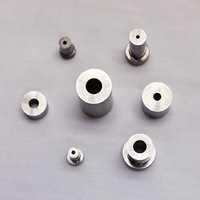 In this article, we will focus on the advantages of typically used material for dies in wire drawing process.
In this article, we will focus on the advantages of typically used material for dies in wire drawing process.
Wire drawing dies are typically available in:
- tool steel,
- tungsten carbide
- diamond, synthetic and natural.
The best die material is determined by the applications and depending on the product needs.
Steel dies are the least expensive and quite suitable in many applications. These are versatile in that they can be reworked to use for drawing larger wire sizes after they wear or are damaged. In some cases where the use of steel dies is appropriate, it might be a waste of money to apply carbide or diamond, so a steel die would be the best.
Carbide button dies have improved durability at a higher cost and for many multi-die operations where die change aren’t frequently done, carbide dies offer a cost effective best solution.
- It improved the productivity and reduced downtime;
- High hardness both at room temperature and high temperatures encountered in drawing operations;
- Having high resistance against deformation under load;
- Smaller thermal coefficient of expansion. As a result, variation in size of dies due to rising working temperatures is minimal;
- its property to receive and maintain high surface finish up to 1 micro inch.
Diamond, being the hardest material, offers the highest wear resistance and is often used when a very narrow dimensional tolerance is needed on the wire. These are the most expensive and best used when needed to support product quality.





